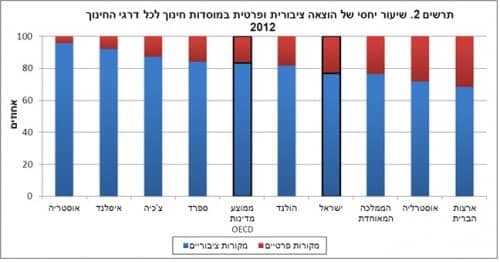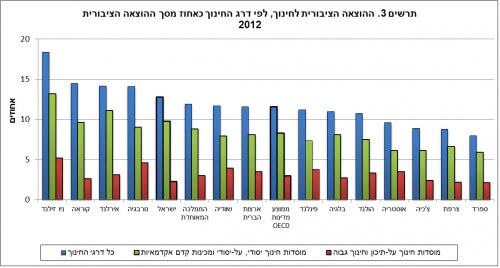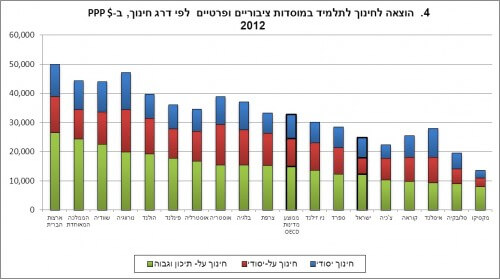This is according to a new report issued by the Central Bureau of Statistics. The reason is that in Israel the percentage of young people is tens of percent higher than in any other country in the OCED - 43% of the population aged 0-24 *Public spending on education is much lower than in other developed countries.

Education in Israel as a percentage of the gross product is among the highest in the countries included in the comparison in the report published yesterday by the Central Bureau of Statistics. In Israel, the national expenditure on education in educational institutions reached 6.5% of GDP. In Iceland and the USA this ratio was similar to Israel and stood at 6.4% of GDP. OECD countries invest an average of 5.3% of GDP in educational institutions. This is evident, among other things, from a study published yesterday by the Central Bureau of Statistics
However, the joy is too early - the comparison of the average expenditure per student at constant international prices (PPP - purchasing power parity) shows that in Israel the average expenditure per student at all levels of education is lower than the average in the OECD member countries. Moreover, the share of public expenditure in financing education expenditure in Israel amounted in 2012 (with the application of the law for financing kindergartens) to 77.1%. The share of public expenditure in the total national expenditure on education in other countries ranges from 68% to 96%.
In post-secondary and higher education, funding from private sources in Israel reaches 48%, higher than the average of the OECD countries - 30%.
The share of compensation for work (wages and related expenses) out of the current expenditure in Israel was among the highest in the OECD countries, at all levels of education in this comparison one must take into account the fact that the percentage of young people in the population in Israel is relatively higher than in the member countries of the OECD, so that in Israel on the one hand the percentage of residents who work and can finance the education is relatively small and on the other hand the percentage of students is relatively high. As a result, the expenditure per student in Israel is smaller. In Israel, in 2012, the percentage of the population aged 24-0 reached 43.4%; For comparison, the percentage of the population aged 24-0 in other OECD countries is much lower and reached an average of 28.5%.
Table A - Population aged 24-0 in Israel and selected countries that are members ofOECD as a percentage of the total population 2012
| Israel | 43.4 |
| Norway | 31.6 |
| United Kingdom | 30.6 |
| France | 30.4 |
| Denmark | 30.3 |
| שוודיה | 29.8 |
| Netherlands | 29.5 |
| Belgium | 29.1 |
| Spain | 25.1 |
| Germany | 24.1 |
| Italy | 24.0 |
The comparison of expenditure in educational institutions according to level of education (shows that in Israel the expenditure was high in the group of institutions of primary, secondary and pre-academic education - 4.4% of GDP compared to 3.7% in OECD countries. In post-secondary educational institutions and institutions of higher education The expenditure from GDP in Israel was 1.6%, similar to the average of the OECD countries - 1.5%.
Public spending on education in Israel (spending in government offices, social security and national institutions, local authorities and government non-profits), including living scholarships for students, reached 2012% of GDP in 5.2, higher than the average of 4.8% in OECD countries.
The share of public spending in financing education spending in Israel amounted in 2012 to 77.1%. The share of public expenditure in the total national expenditure on education in other countries ranges from 68% to 96%.
In the group of institutions of primary, secondary and pre-academic education in Israel, the percentage of public funding in 2012 reached 88.9% - close to the average in OECD countries that year - 90.6%, and similar to the percentage of public funding in Spain - 88.7%.
In post-secondary and higher education, funding from private sources is more common and reaches 47.6% in Israel, higher than the average of the OECD countries - 30.3% and lower than the countries: the United States - 62.2%, and Australia 55.1%. On the other hand, there are countries where private financing is particularly low: Iceland - 9.4%, Luxembourg - 5.2%, Austria - 4.7%, Finland and Norway - 3.8%.
The share of public expenditure on education in the total public expenditure in Israel (Chart 3) was 12.8% - higher than the average in the OECD countries - 11.5%. The share of public expenditure for primary, secondary and pre-academic education out of public expenditure in Israel was 9.8%, higher than the average in the OECD countries - 8.3%.
On the other hand, the share of public expenditure for post-secondary education and higher education of the total public expenditure in Israel was 2.3%, lower than the average of the OECD member countries - 3.0%.


More of the topic in Hayadan:
- Molly Aden - If we don't fundamentally change education, we will have hundreds of thousands of unemployed
- Emergency plan of former President Peres, Minister Bennett and hi-tech companies to double the number of 5 unit math graduates
- Only 7% of the students by 2019 will join the state education


One response
All the central systems in the country are in collapse. The justice system, the health system, the education system, social security and almost every public or state service is drowning in inefficiency, impunity and bureaucracy that inspires panic.
There will be no escape from carrying out far-reaching reforms in all government and public services, because everything is on hold
and waiting to fall apart, and as long as the hundreds of thousands of officials who run our lives are not obliged to productivity measures in order to continue their work, the situation will get worse and worse.
Whoever thinks that everything happens by chance is wrong. The strategy of the State of Israel is to abdicate its responsibility to its citizens and reduce to a minimum the services it provides to them, the way to do this is by destroying the excellent systems that were built when the state was established until the situation becomes a "broken trough", then roll your eyes and propose privatization and taking responsibility
by the citizens.
It may be that some of the systems should indeed become centralized under the state's responsibility to local under municipal or regional responsibility, but the scorched earth method is particularly despicable, not to mention cowardly, and causes many sufferings and distortions
On the way to the bottom of the well.
What keeps the country going are the people, this country is full of wonderful people who in no other place would have been prepared to accept the bureaucratic insolence, the insecurity, the attitude of the authorities and the spin that less than a hundred families control the economy do to them.
The question is until when.